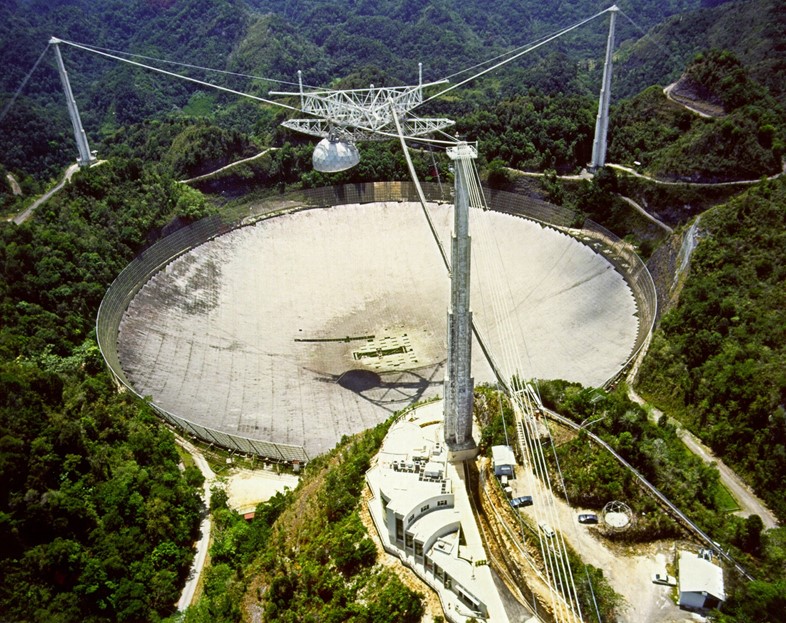super/collider journeys to the karst hills of Puerto Rico, where a huge dish for communication with extraterrestrial civilisations lies hidden amid the jungle
Where on Earth?
Arecibo, Puerto Rico
GPS Coordinates: 1°31′S 29°14′E
It’s hot and humid in the karst hills high above the rainforests of western Puerto Rico, and the road is narrow and winding. With each bend we climb closer to one of the most timelessly futuristic artefacts on Earth: a giant radio telescope nestled within a sinkhole amid the lush jungle. It’s here that the search for extraterrestrial civilisations has been quietly conducted for over three decades, along with some of the most cutting-edge research into our solar system and the wider universe.
Contrasting with the vast, green forest that surrounds it, the Arecibo Observatory is among the largest and most spectacular scientific instruments on the planet. A thousand feet across and 167 feet deep, its dish is made up of nearly 40,000 now-faded aluminium panels, strung across a mesh of steel cables. Delicately suspended nearly 500 feet above is a complex 900-ton triangular platform housing some very sci-fi looking instruments, supported by cables strung from reinforced concrete towers around the rim. The entire complex looks out over the dense jungles and craggy karst peaks of western Puerto Rico, a land of subtropical wet and moist karst forests protected as the nearby Río Abajo State Forest.

What on Earth?
Constructed in the early 1960s, Arecibo was and remains the world’s largest and most sensitive single-aperture radio telescope. China is currently building an even larger one in a very similar landscape in Guizhou province, due to be completed next year. Both work by capturing radio and radar waves from our atmosphere, the solar system and the universe beyond in its massive dish and focussing them onto the central receiver. These faint signals originate from across the distant cosmos: exploding supernovae, spinning pulsars, colliding galaxies and maybe, just maybe, messages from extraterrestrial civilisations.

Among its long list of achievements (measuring the rotation rate of Mercury, confirming the existence of neutron stars and detecting the very first exoplanets etc etc) Arecibo has a played a big part in the quest to find and communicate with life on other worlds. Most of this has been passive, with the huge dish listening out for telltale signs of intelligent communication: repetitive signals sent on narrow bandwidths.
But the observatory can also transmit signals, and sent the first such communication in 1974. Known as the Arecibo Message, this early experiment in interstellar communication was beamed towards the globular star cluster M13, a rich starfield on the edge of the Milky Way. Encoded in binary, the message shows the telescope itself, the numbers one to ten, a human stick figure and our DNA and a representation of the solar system and Earth’s position in it. The message will take 21,000 years (give or take) to reach anyone listening in M13, and a similar time for their reply to reach us, making it more of a thought exercise than a realistic phone call to ET.

How on Earth?
Despite its spectacular location, getting to the Arecibo Observatory is easy. The town of Arecibo is about an hour west along the coast from the capital San Juan. From there, it’s a half-hour drive south into the hills, or you can join an organised bus tour. There’s a visitor centre at the top, and you can camp in the nearby Río Abajo State Forest. For more information on the Observatory, visit their website.







